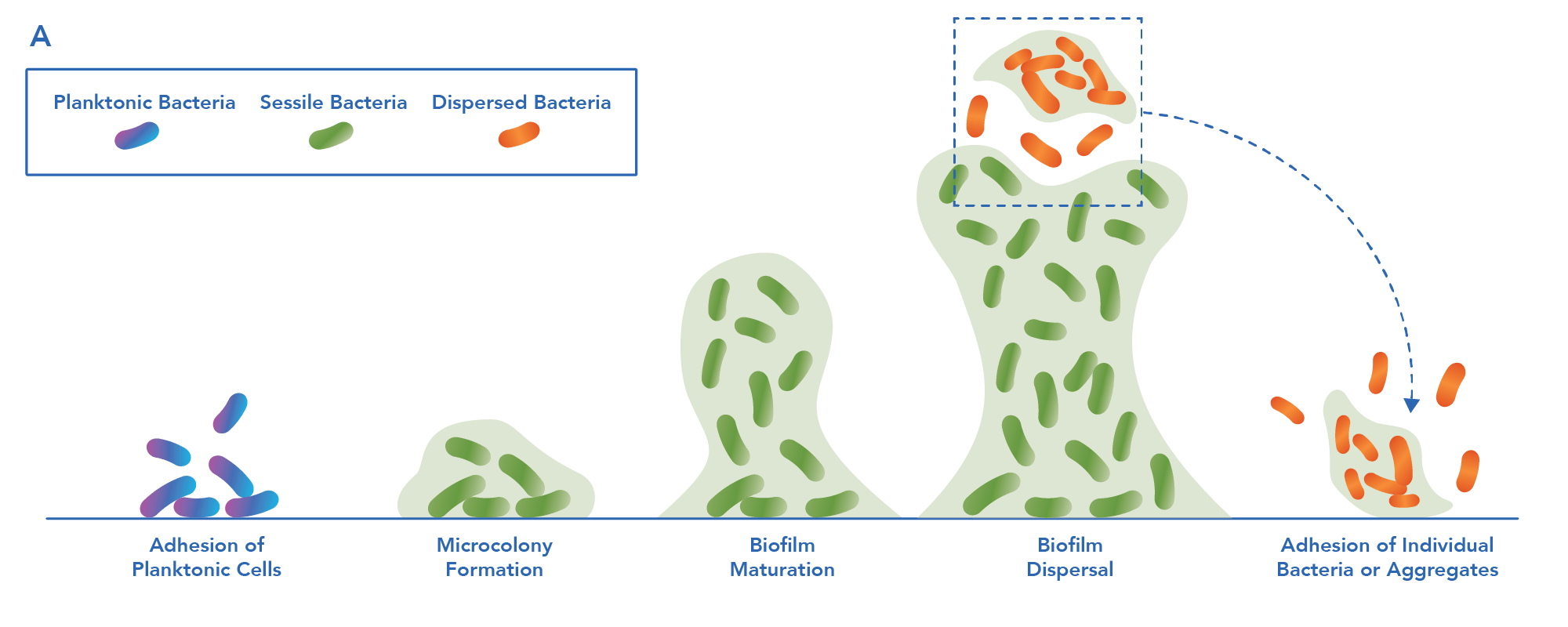En la mayoría de las instalaciones de procesamiento y medioambientales, el biofilm acecha como una amenaza oculta que se esconde en zonas de difícil acceso y alberga patógenos peligrosos que pueden suponer un riesgo de contaminación cruzada. Si profundizamos en el ciclo de vida de las bacterias dentro de una biopelícula, encontramos otra capa de peligro oculto, la dispersión de semillas.
En nuestro primer Fundamentos del biofilm insight, exploramos cómo se forman las biopelículas de organismos que flotan libremente y que pueden adherirse a las superficies y empezar a formar biopelículas. La biopelícula está formada por una sustancia polimérica extracelular (EPS), una matriz de polisacáridos, lípidos y proteínas (López, 2010). Estos organismos tienen dos orígenes: introducción en el sistema de forma externa (entradas al sistema) o desde otro lugar en el sistema después de liberarse de una biopelícula ya formada. Las biopelículas se quedan atrás por una limpieza y eliminación inadecuadas. Este proceso se denomina dispersión por siembra.

Existe una gran variedad de factores que pueden iniciar la dispersión de semillas. Fieles a la complejidad de la vida, se ha demostrado que los factores ambientales, que van desde la falta o la sobreabundancia de nutrientes hasta los cambios de temperatura, pasando por los cambios en el pH o los niveles de oxígeno, pueden iniciar mecanismos de dispersión (Guilhen, 2017).
Una vez que las bacterias reciben la señal de dispersión, se liberan de la biopelícula mediante varios mecanismos: la degradación de la propia matriz de EPS a través de enzimas secretadas o mediante cambios celulares como la reducción de la tensión superficial o la alteración de la estructura celular. (Guilhen, 2017). Ahora las bacterias flotan libremente y pueden volver a adherirse a otras superficies.

Para comprender todas las implicaciones que puede tener la dispersión de la siembra en las superficies de producción de alimentos, es útil imaginar cómo es en un ejemplo del mundo real. En un circuito simple de leche fluida, las bacterias que se encuentran de forma natural en la leche cruda inocularán constantemente el sistema y producirán biopelículas en todo el equipo, al menos hasta el pasteurizador. Si la biopelícula no se elimina por completo y los patógenos peligrosos no se destruyen durante el proceso de saneamiento, las grandes colonias de bacterias establecidas en el sistema acabarán recibiendo la señal de dispersión y se liberarán durante la producción. Los termófilos y las bacterias formadoras de esporas pueden sobrevivir al proceso de pasteurización y restablecer las biopelículas más adelante en la cadena de procesamiento, en la etapa de homogeneización o incluso en el envasado final. (Delgado, 2013). Esto supone un grave riesgo para la salud humana.
En Sterilex, nos enorgullecemos de ser expertos en comprender cómo funciona el biofilm y los riesgos que plantea para el procesado de alimentos y otros entornos. Nuestro sitio web PerQuat® Tecnología es la solución de control de biopelículas más completa del mercado. Los productos Sterilex PerQuat fueron los primeros productos del mercado registrados por la EPA para ambos eliminan las biopelículas de la sanidad pública y eliminan los patógenos de las biopelículas. El uso continuado de los productos PerQuat de Sterilex puede ayudar a garantizar que su sistema esté totalmente limpio mediante el control de la biopelícula, la dispersión de semillas y la siembra del sistema.
Fuentes:
López, D., Vlamakis, H. y Kolter, R. (2010). Biopelículas. Perspectivas en Biología de Cold Spring Harbor, 2(7). doi:10.1101/cshperspect.a000398
Guilhen, C., Forestier, C., & Balestrino, D. (2017). Dispersión de biopelículas: Múltiples estrategias elaboradas para la diseminación de bacterias con propiedades únicas. Microbiología molecular, 105(2), 188-210. doi:10.1111/mmi.13698
Delgado, S., Rachid, C. T., Fernández, E., Rychlik, T., Alegría, Á, Peixoto, R. S., & Mayo, B. (2013). Diversidad de bacterias termófilas en leche cruda, pasteurizada y de cultivo selectivo, evaluada mediante cultivo, PCR-DGGE y pirosecuenciación. Microbiología de los alimentos, 36(1), 103-111. doi:10.1016/j.fm.2013.04.015